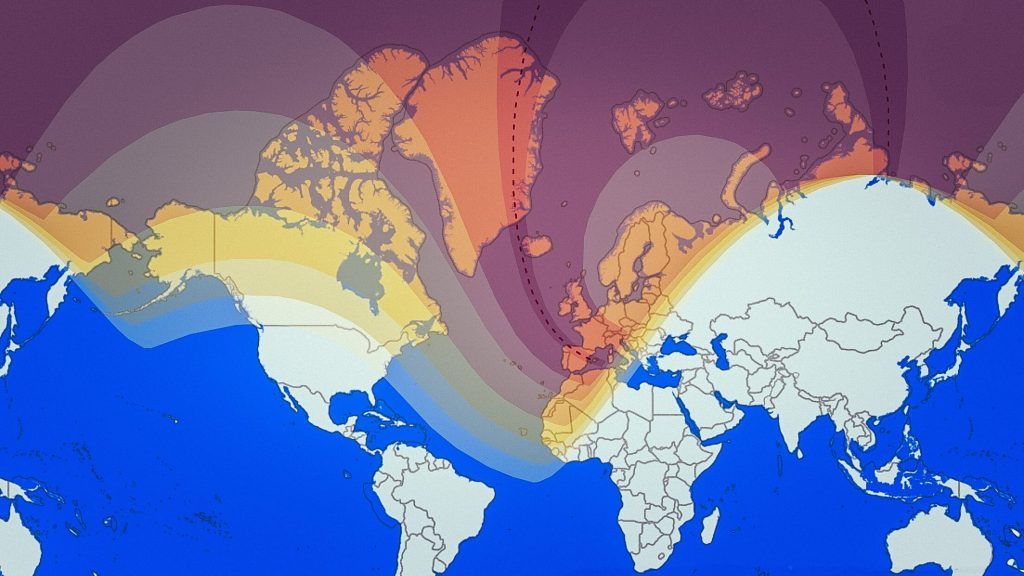- Erin formed in the Atlantic in mid-August 2025 and is the first hurricane of the season.
- As of August 15, 2025, Erin is a Category 1 hurricane with sustained winds near 75 mph and a central pressure around 993 mb, located hundreds of miles east of the northern Leeward Islands and moving west-northwest at about 17–18 mph.
- Forecasters expect Erin to rapidly intensify to a major hurricane (Category 3+) by the weekend and possibly reach Category 4 (130+ mph) by early next week.
- The forecast track shows Erin curving north, passing just north of the Leeward Islands, Virgin Islands and Puerto Rico, then heading toward Bermuda while staying offshore of the U.S. mainland.
- Outer rainbands could drop 2–6 inches of rain on parts of Puerto Rico and the Virgin Islands, with risks of flash floods and mudslides.
- Erin’s impacts include large swells, rough surf, beach erosion, and dangerous rip currents along shores from the Caribbean to the Southeast U.S., even without landfall.
- The toolkit includes GOES-16/17/19 satellites providing near-continuous high-resolution imagery, with GOES-19 infrared detecting cooling cloud tops and a developing eye, updating every 1–5 minutes.
- NOAA and USAF hurricane hunter aircraft, with Doppler radar and dropsondes, plus uncrewed Coyote drones that have logged winds over 190 mph and data for up to 40 minutes.
- Saildrone robotic sailboats have been deployed since 2021 to collect sea-surface data inside eyewalls, including footage from Hurricane Sam’s 50-foot waves in 2021.
- NOAA is operationally using AI-based forecast models alongside traditional physics models in 2025 to reduce track and intensity errors, with human forecasters guiding final judgments.
Hurricane Erin’s Status and Projected Path (Mid-August 2025)
A First Hurricane with Major Potential: Hurricane Erin formed in the Atlantic in mid-August 2025 – the first hurricane of this year’s season [1] [2]. As of August 15, Erin was a Category 1 storm with sustained winds around 75 mph (120 km/h) and a central pressure near 993 mb [3] [4]. The cyclone is located hundreds of miles east of the northern Leeward Islands, tracking west-northwest at roughly 17–18 mph [5] [6]. Forecasters expect Erin to rapidly intensify over abnormally warm Atlantic waters, likely becoming a major hurricane (Category 3+) by the weekend and possibly peaking at Category 4 strength (130+ mph winds) by early next week [7] [8].
Forecast Track: Fortunately, the consensus forecast shows Erin curving northward before directly striking land. The hurricane’s center should pass just north of the Leeward Islands, Virgin Islands, and Puerto Rico over the weekend [9]. Tropical Storm Watches are in effect for parts of the northern Leewards as even a close pass could bring near-tropical-storm-force gusts and heavy rain to those islands [10] [11]. By early next week, Erin is projected to arc north of the Caribbean and aim toward Bermuda, staying offshore of the U.S. mainland [12] [13]. A strong high-pressure ridge and an approaching frontal system should steer Erin away from the U.S. East Coast, according to meteorologists, keeping the core well out at sea [14]. However, even without landfall, Erin’s impacts will be widespread: The storm’s broad circulation will generate large swells, rough surf, beach erosion, and dangerous rip currents along shorelines from the Caribbean and Bahamas to the Southeast U.S. coast [15]. Outer rainbands could also dump 2–6 inches of rainfall on parts of Puerto Rico and the Virgin Islands, raising the risk of flash floods and mudslides in those areas [16]. Local authorities in the U.S. Virgin Islands have already closed some park sites and taken precautions ahead of the storm’s closest approach [17].
Despite being a late starter (Erin arrived just a few days after the climatological average date of the first hurricane [18]), the storm is making up for lost time with its intensification. Residents and travelers across the northern Caribbean are being urged to stay vigilant and monitor updates, as Erin’s exact path could wobble. In Bermuda, officials are warily watching the forecast given the possibility of a close approach or indirect impacts early next week. Along the U.S. East Coast, National Weather Service offices as far north as Florida are already cautioning beachgoers of building swells and rip currents by Monday [19]. All eyes are on Erin’s progress, but thanks to cutting-edge technology and improved forecasts, we have a clearer picture of what this storm is up to than ever before.
High-Tech Tracking: Satellites, Radar and Drones in Action
Today’s meteorologists have an arsenal of advanced tools to scrutinize hurricanes like Erin in real time. Satellite technology is front and center – NOAA’s newest generation of satellites (such as the GOES-16/17 series and the recently deployed GOES-19) provide near-continuous, high-resolution views of the storm from space. In Erin’s case, satellite imagery has shown its cloud pattern becoming more symmetrical with a tightening circulation, early signs of eye formation as the storm strengthens [20]. Infrared sensors detect cooling cloud-top temperatures in Erin’s thunderstorms, indicating vigorous convection fueling the intensification [21]. These satellites refresh images every few minutes (far faster than the 15-minute intervals of 20 years ago [22]), enabling forecasters to catch rapid changes. “Satellites will keep delivering detailed, real-time views of Erin as it develops, supplying essential data to improve tracking and intensity forecasts — not just for this storm, but for others in what may be a highly active 2025 season,” notes one report [23].
On the ground and in the air, radar and reconnaissance aircraft are also pivotal. When Erin nears land or when hurricane hunter aircraft are in the storm, Doppler radar scans reveal its internal structure and wind fields. NOAA’s WP-3D Orion “Hurricane Hunter” planes and U.S. Air Force Reserve aircraft are scheduled to fly into Erin, braving the turbulent eyewall to collect measurements [24]. These crews launch dropsondes (parachuted weather sensors) and utilize tail Doppler radar to map the storm’s winds and rain. Increasingly, they are joined by uncrewed drones that venture where it’s too dangerous for humans: into the turbulent boundary layer just above the ocean surface. In recent years NOAA has experimented with small Coyote drones deployed from hurricane hunter planes, which can dive to a few hundred feet altitude in a raging storm. These hardy robotic scouts have measured winds over 190 mph and transmitted data for up to 40 minutes before meeting their watery end [25] [26]. Such low-level data is extremely valuable – as NOAA scientist Dr. Joe Cione explained, these real-time measurements of winds, temperature, and humidity in the lowest part of a hurricane “provide insight into processes that influence hurricane intensity and intensity change.” [27] They help scientists quantify heat and momentum exchanges between the ocean and storm, key factors in whether a cyclone rapidly intensifies or weakens [28]. The Saildrone uncrewed sailboat is another cutting-edge tool: essentially a robotic ocean vessel that sails into hurricanes, it records sea surface conditions and storm data from ocean level. Since 2021, NOAA has deployed fleets of these hardy saildrones to intercept tropical cyclones, transmitting live video and meteorological data from inside the eyewalls of monster storms [29]. (One famously captured footage from inside Category 4 Hurricane Sam’s 50-foot waves in 2021.) For Erin, any data from reconnaissance missions – manned or unmanned – will be fed into forecast models to sharpen the predictions.
In addition to new instruments, forecasters benefit from faster data processing and better model integration. Modern hurricane models assimilate a wide array of observations: satellite snapshots, radar scans, aircraft data, buoys, and more. “Access to a wide net of real-time weather data allows forecast models to have a better idea of current conditions and a more accurate starting point,” explains lead forecaster Phil Grigsby of the National Weather Service. “They take all of the hurricane hunter data, all of the data sets – satellite data, observational data, radar data – and that goes into the models.” [30] This flood of information, combined with supercomputing power, enables simulations of Erin’s future track and strength with ever-increasing fidelity.
Smarter Forecasts with AI and Supercomputers
Forecasting hurricanes has always been a high-tech endeavor, but 2025 marks a turning point: for the first time, NOAA is operationally using artificial intelligence models alongside its traditional physics-based models [31] [32]. Wallace Hogsett, Science and Operations Officer at NOAA, called this year “a pivotal year” for hurricane forecasting: “We were looking at [AI models] a little last year, but this is the first year they will be part of the suite of models that we’re looking at.” [33] These AI models don’t replace the trusted physics equations, but they augment the forecast process. Instead of crunching purely through fluid dynamics, an AI system can rapidly analyze decades of historical hurricane data (the “30, 40, 50 years of four-dimensional data” Hogsett describes) to find patterns and make predictions [34]. The goal is to reduce errors in track and intensity forecasts, giving communities a clearer picture of what’s coming [35]. Hogsett notes that traditional models are computationally intensive and take time, whereas “AI can help speed it up, and decrease errors,” effectively turbo-charging the forecast process [36] [37]. Early hopes are that AI guidance will continue the trend of steadily improving hurricane forecasts – which, for track predictions, have seen error rates drop dramatically over the past few decades. (In fact, thanks to projects like the Hurricane Forecast Improvement Project, the average 5-day track forecast error today is about equal to the 2-day error in the mid-1990s [38]. Forecasters can now predict five days out with the accuracy they once had for two days out – a testament to better models and data.)
However, experts caution that AI is “simply another tool” in the toolbox [39]. Human meteorologists still synthesize the final forecast, especially for complex aspects like sudden intensity changes. “AI is probably the future, but we’re not there yet,” said veteran forecaster Paul Dellegatto, emphasizing that human expertise and multiple model inputs remain crucial [40]. If the AI models prove reliable this season with storms like Erin, NOAA indicates they could be integrated permanently into operations going forward [41].
Behind both AI and traditional models is an ever-growing backbone of supercomputing muscle. Just before this hurricane season, NOAA upgraded its supercomputers, enabling higher-resolution models and larger “ensemble” runs (where dozens of model variations are tested). NOAA’s new flagship hurricane model – the Hurricane Analysis and Forecast System (HAFS) – received an upgrade for 2025 that is expected to improve track and intensity forecast accuracy by another ~5% [42]. Even small percentage gains are significant, potentially translating to tens of miles more precision in the track cone or better timing of intensity changes. HAFS also improves prediction of rapid intensification by an estimated 5–7%, an area of forecasting that remains challenging [43]. “In my 30 years at the National Weather Service, we’ve never had more advanced models and warning systems in place to monitor the weather,” says NWS Director Ken Graham, underscoring how far forecasting science has come [44]. The wealth of computer model guidance is clearly on display with Erin – forecasters have been comparing many models and their ensemble runs. Notably, the normally uncertain early track for Erin was very well anticipated: “The wealth of model ensemble forecasts now available…has been proving its value with Erin,” meteorologist Bob Henson observed, noting that while individual model runs wobbled, the overall consensus held steady, correctly indicating Erin would likely turn north and miss Florida [45] [46]. This consistency gave officials extra confidence in issuing timely advisories. Still, experts remind us that intensity forecasts lag behind track forecasts in accuracy – rapid strengthening (like what’s expected for Erin) can still surprise models, so researchers continue to refine both physics-based and AI models for that “last mile” of hurricane prediction [47].
To summarize some of the innovative tech tools coming to bear in Hurricane Erin’s case, here is a quick overview:
| Technology/Tool | How It’s Being Used for Hurricane Erin (2025) |
|---|---|
| Next-Gen Satellites (GOES-16/17/19, CubeSats) | Constant high-resolution imagery of Erin’s clouds, structure, and lightning. For example, GOES-19 infrared scans showed Erin’s cold cloud tops and emerging eye, signaling intensification [48] [49]. Frequent updates (every 1–5 minutes) allow near-real-time monitoring of storm evolution. |
| Hurricane Hunter Aircraft & Radar | Crewed NOAA and Air Force planes fly into Erin’s core, measuring winds, pressure, and more. Onboard Doppler radar maps the storm’s 3D wind field. Dropsonde data and radar scans are fed into forecast models to improve predictions [50] [51]. These missions also help confirm if Erin’s strength and structure match satellite estimates. |
| Uncrewed Drones (Air & Sea) | Small Coyote drones launched from aircraft descend into Erin’s fiercest winds, gathering low-level data on wind speeds, temperature, and humidity that manned planes cannot safely obtain [52] [53]. Saildrones (surface drones) can sail into the hurricane’s ocean footprint, measuring sea surface conditions and feeding back critical data to scientists. All this new data improves understanding of intensity changes. |
| AI-Based Forecast Models | Experimental artificial intelligence models are being tested alongside traditional models. Trained on decades of cyclone data, they rapidly generate forecast scenarios for Erin’s track and intensity. NOAA hopes they will reduce error margins and catch patterns human forecasters might miss [54]. Early use in 2025 has AI as an additional guidance tool (with human oversight) in predicting Erin’s behavior. |
| Supercomputers & Enhanced Models | NOAA’s upgraded supercomputers run advanced models like HAFS, which has been refined for better accuracy this season [55]. Faster computing also enables ensemble forecasting – dozens of runs to capture uncertainty. For Erin, ensembles have helped confirm the forecast track (turning northward) with high confidence [56] [57]. More computer power means forecasters can provide a 5-day cone today as reliable as a 3-day cone was 15–20 years ago. |
Expert Insights: What Meteorologists and Officials Are Saying
The advent of Hurricane Erin has experts in weather and emergency management weighing in on both the storm itself and the tools being used to confront it. There is a mix of awe at how far forecasting has advanced and caution about the storm’s hazards.
Meteorologists on Forecasting Advances: Seasoned forecasters draw comparisons to past benchmark storms to illustrate technological progress. Bob Breck, a veteran New Orleans meteorologist who lived through Hurricane Katrina in 2005, remarked on the revolution in forecasting since those days. “We couldn’t comprehend, say 30 years ago, what we would now have. We take it for granted,” Breck said, referring to today’s dynamic modeling and constant data streams [58]. During Katrina’s era, satellite images came every 15 minutes and forecast cones extended only 3 days; now we get updates every few minutes and 5-day (even 7-day) cones that are much more precise [59] [60]. “They [the public] think that the models are so good that they’re right…maybe 90% of the time they are right,” Breck noted – though he cautioned that people shouldn’t become complacent, as a small forecast error can still have big consequences if you’re unprepared just outside the cone [61]. Another expert, NWS forecaster Phil Grigsby, highlighted that intensity forecasting remains the “work in progress” now that track forecasts have improved so greatly. Rapid intensification events are a particular challenge that ongoing research (including AI and new data collection) aims to tackle [62]. Hurricane Erin’s expected jump to major hurricane status will be a real-world test of some of these intensity prediction improvements.
Climate Scientists’ Perspective: While not a direct focus of immediate forecasts, climate experts observe that Erin is traversing exceptionally warm ocean waters – part of a broader trend of warming seas. The stretch between the Bahamas and Bermuda, where Erin is headed, has heat content that can fuel a Category 4 storm per forecasts [63]. Scientists have noted that warmer oceans (partly attributable to climate change and this year’s El Niño) are linked with more frequent rapid intensification. Erin’s development also fits into a pattern of recent busy seasons: NOAA’s mid-season outlook continues to call for an above-normal hurricane season in 2025 [64] [65]. However, one silver lining of improved science is that we can better predict and prepare for whatever storms do form. As Dr. Laura Grimm, NOAA’s acting administrator, put it: “NOAA is critical for the delivery of early and accurate forecasts and warnings, and provides the scientific expertise needed to save lives and property.” [66] Early warnings – like those for Erin – give communities precious time to brace themselves even as climate factors raise the stakes.
Emergency Management and Preparedness: Officials in emergency management are emphasizing the value of preparation and leveraging new tools. “This outlook is a call to action: be prepared,” warns Ken Graham of the NWS, urging residents to make plans and gather supplies before storms threaten [67]. In North Carolina, which suffered a devastating hit from Hurricane Helene just last year in this scenario, local leaders echoed that “early preparation is critical to protect lives and property before a storm makes landfall.” [68] Hurricane Erin may not be projected to make U.S. landfall, but such messages are timely reminders for all coastal residents to stay ready during peak season.
Emergency managers are also increasingly relying on digital decision-support systems. For instance, the HURREVAC platform (Hurricane Evacuation) combines real-time forecast data from NHC with inundation modeling to help officials decide if and when to order evacuations [69]. These kinds of tools didn’t exist or were far more crude in past decades, and they significantly improve the timing and targeting of public safety actions. As Commerce Secretary Howard Lutnick – whose department oversees NOAA – noted, “NOAA and the National Weather Service are using the most advanced weather models and cutting-edge hurricane tracking systems to provide Americans with real-time storm forecasts and warnings. With these models and tools, we have never been more prepared for hurricane season.” [70]
Public Response and Real-Time Information: “There’s an App (and Map) for That”
From government agencies to volunteer groups, there’s a major emphasis on getting timely information to the public as Hurricane Erin churns offshore. In 2025, people have more ways than ever to stay informed and receive warnings – often literally in the palms of their hands.
Official Alerts and Apps: Federal and local agencies are pushing out alerts through multiple channels. The FEMA mobile app is a key tool, allowing users to receive real-time weather warnings for up to five chosen locations, find emergency shelter locations, and access safety tips on what to do before, during, and after a hurricane [71]. The app even offers text messaging for critical info, recognizing that in some disasters simple SMS may get through when other services fail [72]. The National Hurricane Center and National Weather Service, meanwhile, maintain a constant online presence – their websites and social media accounts provide updated forecast tracks, interactive maps, and “key messages” for storms like Erin. The NHC’s website (hurricanes.gov) is considered the gold standard for hurricane info by many responders [73] [74], and it’s freely accessible to all. “Honestly, the National Hurricane Center really is the best in the biz,” says Team Rubicon disaster responder Drew Hannah; most other apps and outlets ultimately rely on NHC’s data as their source [75]. For localized info, users can follow their local NWS office social media or website to get tailored warnings (e.g., flash flood advisories or marine alerts specific to their area) [76]. And of course, traditional outlets like television and radio still play a big role, often integrating these modern data feeds into their broadcasts.
Live Tracking Tools for Everyone: The public today can also tap into powerful mapping technology to watch storms in real time. Websites and apps provide live hurricane trackers – for example, interactive maps that plot Erin’s current position, forecast cone, and even spaghetti model lines. Services like Zoom.Earth and various media websites offer satellite loops and radar overlays that anyone can view online [77]. Fox Weather, as “Your Hurricane HQ,” has been promoting its own live tracker with forecast cones and model plots for Erin [78] [79]. This democratization of data means an interested person can see nearly the same information as a meteorologist, increasing awareness (though officials caution users to interpret cautiously and heed official forecasts). The NHC’s forecast cone graphics, for instance, are widely shared on social media to communicate where Erin is likely to go and where to expect hazards [80].
Social Media & Crowdsourced Updates: Social platforms have become a double-edged sword in disasters – they can spread rumors, but also invaluable real-time reports. Emergency managers are now actively monitoring social media for situational awareness. “Some of the best storm- and hurricane-tracking comes via social media,” notes Team Rubicon’s Alex MacInnis. Twitter (now X) is especially useful, with dozens of credible meteorologists, agencies, and even storm chasers posting live updates. For example, official accounts like @NWSNHC (NHC), @FEMA, @NOAA_HurrHunter and various local NWS offices disseminate warnings and storm insights on Twitter [81]. Responders also scour Twitter for on-the-ground damage reports once a storm hits – it can reveal which areas have flooding, wind damage, or need help, sometimes faster than calls to 911 in a overwhelmed system [82]. In a creative twist, Snapchat has also emerged as a tool: “We use the Snap Map to see if people have uploaded photos and are asking for help,” says MacInnis, referring to Snapchat’s location-based public posts [83]. After a hurricane, this can literally highlight neighborhoods in need on a map, guiding rescue teams. For Hurricane Erin – should it significantly impact Bermuda or any coastlines – you can expect to see hashtags like #Erin or #PRwx (Puerto Rico weather) trending with firsthand accounts and images. Authorities encourage the public to engage with these tools wisely: share verified information, use official hashtags for reporting issues, and always follow directives from local officials over anything else [84].
Community & Government Preparedness: Beyond information, governments are taking concrete steps to prepare and assist. Coastal communities in the potential path of Erin’s waves are fortifying beaches and advising swimmers to stay out of the water during high surf advisories. In Bermuda, officials have likely reviewed shelter readiness and ensured back-up communications are in place given the island’s vulnerability in the open Atlantic. U.S. states along the East Coast are using Erin as a drill of sorts – checking that hurricane emergency kits and generators are ready, even if this storm stays offshore. The Coast Guard issued reminders at the season’s start for boaters to have a hurricane plan and for coastal residents to know their evacuation routes, with emphasis on using multiple alert methods (like receiving both phone and NOAA Weather Radio alerts) in case one fails [85]. And volunteer organizations such as the Red Cross and Team Rubicon have volunteers on standby, mobilizing supplies and personnel just in case Erin’s effects require a response.
From a broader perspective, Hurricane Erin is showcasing how far we’ve come in using technology and data to deal with hurricanes. Compared to past eras, we have more lead time to prepare, more accurate predictions of where the dangers will be, and more ways to communicate those threats rapidly to those in harm’s way. As one NOAA administrator put it, we have “never been more prepared for hurricane season” than we are now [86]. Yet, each storm is a unique test. Erin’s ongoing journey will be closely analyzed not only to protect people this week, but also to learn lessons that further improve the science and art of hurricane forecasting. In the end, the fight against these natural forces is greatly aided by high-tech insight, but it still relies on human judgment and public vigilance. Hurricane Erin, with all our modern tools pointed at it, serves as a timely reminder that preparedness and respect for nature’s power remain as important as ever.
Sources: Current official forecasts and advisories from NOAA/National Hurricane Center [87] [88]; news and expert analysis from Fox26 Houston [89] [90], Yale Climate Connections [91] [92], CBS News [93], Space.com [94] [95], FOX 13 Tampa (NOAA AI models) [96] [97]; NOAA officials’ statements in Carolina Journal [98] [99]; historical context from Fox8 New Orleans [100] [101]; and preparedness information from FEMA, Team Rubicon, and Ready.gov [102] [103].
References
1. www.fox26houston.com, 2. yaleclimateconnections.org, 3. www.nhc.noaa.gov, 4. yaleclimateconnections.org, 5. www.nhc.noaa.gov, 6. yaleclimateconnections.org, 7. www.fox26houston.com, 8. yaleclimateconnections.org, 9. www.nhc.noaa.gov, 10. www.nhc.noaa.gov, 11. yaleclimateconnections.org, 12. www.fox26houston.com, 13. www.fox26houston.com, 14. www.cbsnews.com, 15. yaleclimateconnections.org, 16. www.nhc.noaa.gov, 17. www.cbsnews.com, 18. yaleclimateconnections.org, 19. yaleclimateconnections.org, 20. www.space.com, 21. www.space.com, 22. www.fox8live.com, 23. www.space.com, 24. www.nhc.noaa.gov, 25. blog.ametsoc.org, 26. blog.ametsoc.org, 27. blog.ametsoc.org, 28. blog.ametsoc.org, 29. www.pmel.noaa.gov, 30. www.fox8live.com, 31. www.fox13news.com, 32. www.fox13news.com, 33. www.fox13news.com, 34. www.fox13news.com, 35. www.fox13news.com, 36. www.fox13news.com, 37. www.fox13news.com, 38. www.fox8live.com, 39. www.fox13news.com, 40. www.fox13news.com, 41. www.fox13news.com, 42. www.carolinajournal.com, 43. www.facebook.com, 44. www.carolinajournal.com, 45. yaleclimateconnections.org, 46. yaleclimateconnections.org, 47. www.fox8live.com, 48. www.space.com, 49. www.space.com, 50. www.nhc.noaa.gov, 51. www.fox8live.com, 52. blog.ametsoc.org, 53. blog.ametsoc.org, 54. www.fox13news.com, 55. www.carolinajournal.com, 56. yaleclimateconnections.org, 57. yaleclimateconnections.org, 58. www.fox8live.com, 59. www.fox8live.com, 60. www.fox8live.com, 61. www.fox8live.com, 62. www.fox8live.com, 63. yaleclimateconnections.org, 64. www.space.com, 65. www.cbsnews.com, 66. www.carolinajournal.com, 67. www.carolinajournal.com, 68. www.carolinajournal.com, 69. www.fema.gov, 70. www.carolinajournal.com, 71. teamrubiconusa.org, 72. teamrubiconusa.org, 73. teamrubiconusa.org, 74. teamrubiconusa.org, 75. teamrubiconusa.org, 76. teamrubiconusa.org, 77. zoom.earth, 78. www.foxweather.com, 79. www.foxweather.com, 80. www.nhc.noaa.gov, 81. teamrubiconusa.org, 82. teamrubiconusa.org, 83. teamrubiconusa.org, 84. teamrubiconusa.org, 85. www.news.uscg.mil, 86. www.carolinajournal.com, 87. www.nhc.noaa.gov, 88. www.nhc.noaa.gov, 89. www.fox26houston.com, 90. www.fox26houston.com, 91. yaleclimateconnections.org, 92. yaleclimateconnections.org, 93. www.cbsnews.com, 94. www.space.com, 95. www.space.com, 96. www.fox13news.com, 97. www.fox13news.com, 98. www.carolinajournal.com, 99. www.carolinajournal.com, 100. www.fox8live.com, 101. www.fox8live.com, 102. teamrubiconusa.org, 103. teamrubiconusa.org










